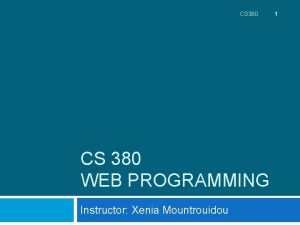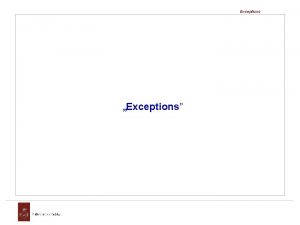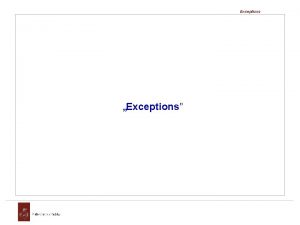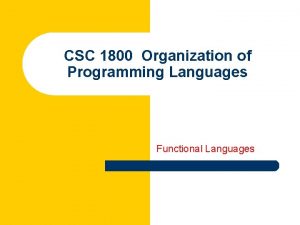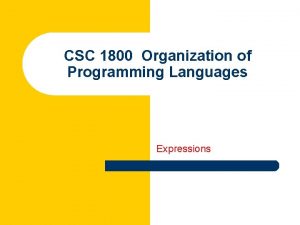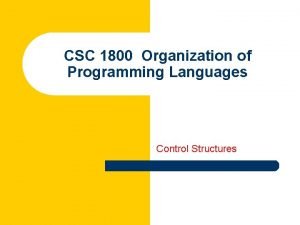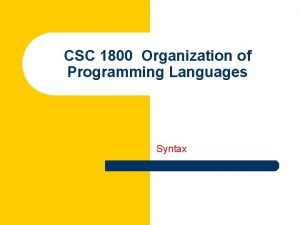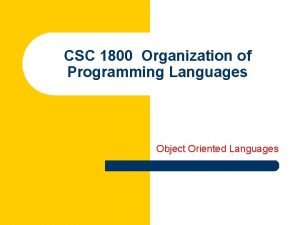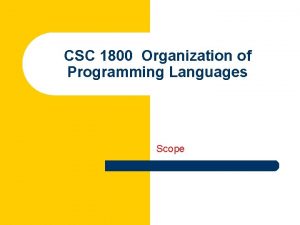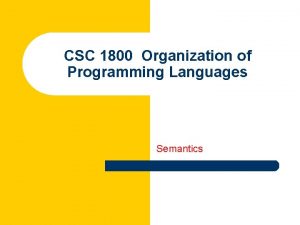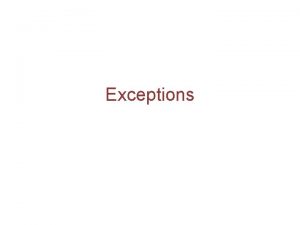CSC 1800 Organization of Programming Languages Exceptions Introduction









![Throwing Exceptions l Exceptions are all raised explicitly by the statement: throw [expression]; l Throwing Exceptions l Exceptions are all raised explicitly by the statement: throw [expression]; l](https://slidetodoc.com/presentation_image_h2/2f59efbbda50f5dda7b845240e376a33/image-10.jpg)




- Slides: 14

CSC 1800 Organization of Programming Languages Exceptions

Introduction to Exception Handling l In a language without exception handling – l When an exception occurs, control goes to the operating system, where a message is displayed and the program is terminated In a language with exception handling – Programs are allowed to trap some exceptions, thereby providing the possibility of fixing the problem and continuing 2

Basic Concepts l l Many languages allow programs to trap input/output errors (including EOF) An exception is any unusual event, either erroneous or not, detectable by either hardware or software, that may require special processing The special processing that may be required after detection of an exception is called exception handling The exception handling code unit is called an exception handler 3

Advantages of Built-in Exception Handling l l l Error detection code is tedious to write and it clutters the program Exception handling encourages programmers to consider many different possible errors Exception propagation allows a high level of reuse of exception handling code 4

Design Issues l l l How are user-defined exceptions specified? Should there be default exception handlers for programs that do not provide their own? Can built-in exceptions be explicitly raised? Are hardware-detectable errors treated as exceptions that can be handled? Are there any built-in exceptions? How can exceptions be disabled, if at all? 5

Design Issues (continued) l l l How and where are exception handlers specified and what is their scope? How is an exception occurrence bound to an exception handler? Can information about the exception be passed to the handler? Where does execution continue, if at all, after an exception handler completes its execution? (continuation vs. resumption) Is some form of finalization provided? 6

Exception Handling in C++ l l Added to C++ in 1990 Design is based on that of CLU, Ada, and ML 7

C++ Exception Handlers l Exception Handlers Form: try { -- code that is expected to raise an exception } catch (formal parameter) { -- handler code }. . . catch (formal parameter) { -- handler code } 8

The catch Function l l catch is the name of all handlers--it is an overloaded name, so the formal parameter of each must be unique The formal parameter need not have a variable – l l It can be simply a type name to distinguish the handler it is in from others The formal parameter can be used to transfer information to the handler The formal parameter can be an ellipsis, in which case it handles all exceptions not yet handled 9
![Throwing Exceptions l Exceptions are all raised explicitly by the statement throw expression l Throwing Exceptions l Exceptions are all raised explicitly by the statement: throw [expression]; l](https://slidetodoc.com/presentation_image_h2/2f59efbbda50f5dda7b845240e376a33/image-10.jpg)
Throwing Exceptions l Exceptions are all raised explicitly by the statement: throw [expression]; l The brackets are metasymbols A throw without an operand can only appear in a handler; when it appears, it simply re-raises the exception, which is then handled elsewhere The type of the expression disambiguates the intended handler l l 10

Unhandled Exceptions l l l An unhandled exception is propagated to the caller of the function in which it is raised This propagation continues to the main function If no handler is found, the default handler is called 11

Continuation l l After a handler completes its execution, control flows to the first statement after the last handler in the sequence of handlers of which it is an element Other design choices – – – All exceptions are user-defined Exceptions are neither specified nor declared The default handler, unexpected, simply terminates the program; unexpected can be redefined by the user Functions can list the exceptions they may raise Without a specification, a function can raise any exception (the throw clause) 12

Evaluation l l It is odd that exceptions are not named and that hardware- and system software-detectable exceptions cannot be handled Binding exceptions to handlers through the type of the parameter certainly does not promote readability 13

Summary l l l Ada provides extensive exception-handling facilities with a comprehensive set of built-in exceptions. C++ includes no predefined exceptions Exceptions are bound to handlers by connecting the type of expression in the throw statement to that of the formal parameter of the catch function Java exceptions are similar to C++ exceptions except that a Java exception must be a descendant of the Throwable class. Additionally Java includes a finally clause 14
 Introduction to programming languages
Introduction to programming languages Real-time systems and programming languages
Real-time systems and programming languages Cs 421
Cs 421 Multithreading program in java
Multithreading program in java Programming languages levels
Programming languages levels Plc
Plc Joey paquet
Joey paquet Comparative programming languages
Comparative programming languages Alternative programming languages
Alternative programming languages Types of programming languages
Types of programming languages Transmission programming languages
Transmission programming languages Adam doupe cse 340
Adam doupe cse 340 Integral data type example
Integral data type example Xenia programming languages
Xenia programming languages Advantages and disadvantages of system software
Advantages and disadvantages of system software













